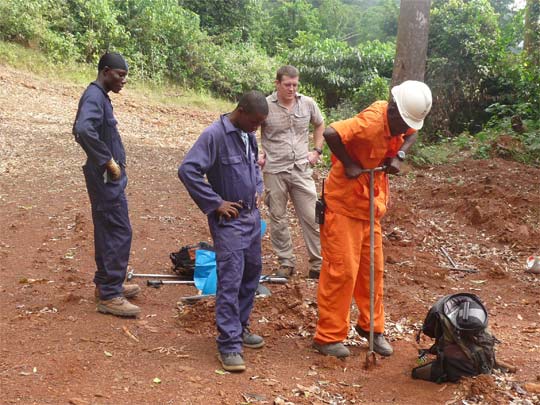A Liberian experience
Land Research Associates has recently been helping Schlumberger Water Services with the soil geochemical study for a proposed iron-ore mine in south-east Liberia. The Putu iron ore project is part of a 425 km² exploration tenement majority-owned by Severstal Resources. The resource includes a 12 km ridge of haematite- and magnetite-banded iron formation. The upper half of the ridge, near Tiama Town, would be removed, processed and the outputs exported by a new railway leading to a purpose-built harbour on the coast.
LRA’s role was to provide baseline soils data in support of the soil geochemical study. This was achieved through reconnaissance soil mapping, undertaken by Malcolm Reeve in January 2012 of a 132 km2 area extending along the length of the Putu mountain ridge and down to the valley floor on each side. The survey was based on soil observations along a series of transects across the topography, many of them associated with surface soil sampling for the geochemical studies. As part of this, training in sampling by soil auger was provided for the local hydrology team who were assisting with the work. Much of the survey area was covered by thick rainforest or selectively logged forest and access through the thickest parts was only possible by slowly cutting a trail by machete. Consequently, soil observations were mainly limited to land alongside dirt roads created to provide access to drill platforms, lower slope clearings for informal agriculture or farmer or hunter paths through the bush.
Six soil units were defined and characterised, and a reconnaissance soil map produced in ArcGIS, assisted by excellent quality aerial photography that was being flown during the latter stages of the survey. The reconnaissance soil map will not only help the geochemical study but is expected to be useful as part of the environmental impact assessment and mitigation proposals, if native villages are displaced by tailings dumps and water treatment facilities.

Footnote: Although founded by freed American and Caribbean slaves, Liberia is mostly inhabited by indigenous Africans, with the slaves' descendants comprising 5% of the population. Two civil wars, the first starting when Charles Taylor's National Patriotic Front of Liberia (NPFL) militia overran much of the countryside in the late 1980s, destroyed Liberia's economy, left 250,000 dead and created thousands of refugees. Foreign investment has now restarted but the country’s infrastructure is poor and the road journey from Monrovia airport to Putu is a painful and dirty 10 hour trip -a separate story on its own!
